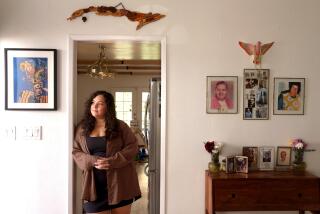Stalled at the starting line
On the same night that the Senate was killing legislation to bail out U.S. automakers last week, seniors in vehicle design at Pasadena’s Art Center College of Design were putting on what should have been the show of their young lives.
Standing in suits beside sleek, carefully constructed models of futuristic-looking cars and video screens with 3-D renderings, they smiled and handed out resumes, hoping to catch the eye of a car company recruiter.
Almost none were to be found.
“Normally there are a lot of designers from the big companies, but with all that’s going on, nobody is coming,” said Julius Bernardo, 27, who has dreamed of designing flashy cars since childhood and spent about $100,000 on his education. “At this point in time, you have to start thinking about other kinds of jobs.”
In normal times, the senior show at Art Center, one of the world’s top transportation design schools, is an employment gold mine, an auto-world agora where carmakers go to stock their studios with talent and put them to work on the vehicles of the future. Industry legends such as BMW’s design chief Chris Bangle and former Aston Martin designer Henrik Fisker walked almost directly out of their senior shows and into automotive history.
But with the industry suffering its worst sales decline in a quarter-century -- General Motors Corp. and Chrysler are awaiting word on $14 billion in emergency aid from the Bush administration, and Ford is only slightly better off -- these are not normal times.
Carmakers, desperate to cut costs, have reduced or frozen hiring. Product planning and design have taken a hit, on top of layoffs on the assembly line, pay cuts in the executive suite and reductions on a host of expenses including auto shows and office supplies.
Although designers make up a tiny fraction of the workers in the auto industry, their importance is immeasurable; without good design, cars don’t sell. A car company without designers has no future.
GM has cut its research and development budget and told Congress this month that it would eliminate eight models by 2012. Ford has cut back on plans for new truck designs. And Chrysler, which in March closed its advanced design studio in Carlsbad, Calif., has seen its design staff shrink by about 15 in the last year from about 75.
“There’s no question that this is a hard time, and there’s no indication it’s going to get better in the near term,” said Larry Erickson, a former designer at GM and Ford and now chairman of the transportation design department at the College for Creative Studies in Detroit, which rivals the Art Center in prestige.
The Detroit college has long been a pipeline to jobs at the Big Three, and Erickson said that until recently, half of each graduating class, which generally ranges from 10 to 20 students, would land positions in carmakers’ studios.
But last spring, when the college’s seniors had their big show, only one got a job at an automaker, students said. A second found work designing bicycles. The rest are still looking, or working in design jobs outside transportation.
“They told us ahead of time, and they were right, that it was going to be a really bad year,” said Mykola Kindratyshyn, the lone hire from that class. He turned down an offer from Toyota to choose GM, where he designs Cadillacs. “In the past, everybody got offers. If you didn’t get a job with a car company, you were sure a supplier would hire you. Not anymore.”
Known primarily for architecture and engineering, Lawrence Technological University in Southfield, Mich., began offering a major in transportation design last year. Jessica Cojeen, a sophomore, said six students dropped out of her class after the first year, discouraged, in part, by poor job prospects.
“We’re extremely nervous,” said Cojeen, whose father works in purchasing for GM. Her professors are encouraging students to develop skills outside vehicle design, such as designing shoes, clothing and other consumer goods. “If you can’t get a job for a carmaker, you could still get a job designing Hot Wheels,” she said.
At Thursday night’s Art Center show, Sean Whang, who moved to Southern California from Seattle to get his degree, presented a car model he imagines for a Japanese anime character. But his display included the redesign of a blow-dryer.
Although his fellow December graduates still hold out hope for a job at Toyota or Honda -- representatives of both companies attended the show but made no job offers -- Whang said he had his sights set on Samsung Electronics Co., where he’d like to design cellphones. “I learned to draw and think like a car designer, but now I’m going to apply it to consumer products,” he said.
Ralph Gilles, vice president of design for Chrysler, recalled that in 1991, the year before he graduated from the College for Creative Studies, a slow economy kept most graduates from getting offers. But Gilles managed to land a job at Chrysler when he finished school, and said that soon the company was “hiring like crazy.”
Gilles, best known for leading the design on the Chrysler 300, said aspiring designers shouldn’t give up hope.
“This is a cyclical thing,” he said. This year, he’s lost nearly 20% of his designers, mostly to voluntary buyouts, and has been able to hire only two people -- both experienced designers rather than fresh graduates. “At this moment, we are definitely leery.”
For students, one option has been more school. Whang and other Art Center students said five of their classmates elected to postpone their graduation by six months in hopes that the industry would be on better footing by May. In the fall, the College for Creative Studies will become the first U.S. school to offer a master’s degree in transportation design, which may attract designers hoping to hold out for better times.
Although designing exteriors is akin to having what one student called “rock star” status, the industry has a shortage of designers focusing on the dashboard, seats and other accouterments on the other side of the sheet metal.
Ricky Wong, who is from Hong Kong and is on track to graduate in August, is interning at Fisker Automotive Inc., Henrik Fisker’s start-up in Irvine, helping design the interior of the Karma, an $87,000 plug-in hybrid due out next year.
“The economy is bad, so I’m focusing on interiors,” said Wong. “That’s what’s hot right now.”
Eric Noble teaches at the Art Center when he isn’t running his auto industry consulting firm in Orange. He said he and other faculty members had been encouraging students to develop their portfolios beyond cars and to be flexible.
“It’s tough,” Noble said. “We’re training way more designers than can be absorbed by the industry.”
--






